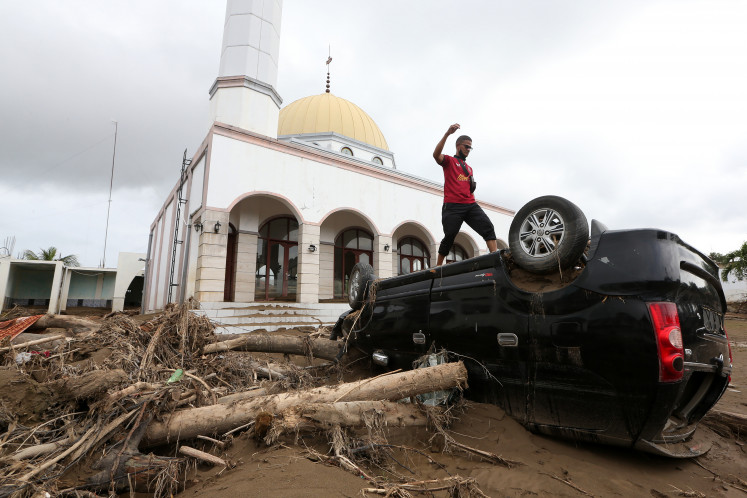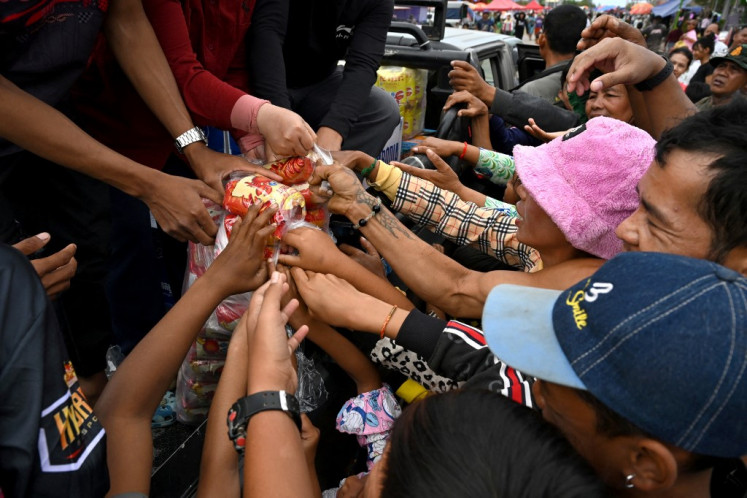Popular Reads
Top Results
Can't find what you're looking for?
View all search resultsPopular Reads
Top Results
Can't find what you're looking for?
View all search resultsMuaro Jambi Temple: The Legacy of Ancient Jambi
Visitors to Jambi province may not have a clue about the treasure it possesses
Change text size
Gift Premium Articles
to Anyone
V
/span>Visitors to Jambi province may not have a clue about the treasure it possesses. But there it is – the Muaro Jambi Temple Complex, one of the largest ancient temple complexes in Southeast Asia, housing eight excavated temples and many more that remain hidden.
The huge antediluvian temple complex stretches 7.5 kilometers along the Batanghari River, covering an area of around 12 square kilometers.
The temples within the complex are believed to date back to Buddhist and Hindu civilizations that developed in Sumatra as early as the 4th century during the reign of the Malay kingdom, which lasted until the establishment of the Sriwijaya kingdom in the 13th century.
While no definite conclusion has been reached about the length of time it took to construct the complex, its influence on Buddhist study at that time is undisputed.
Some parts were built by the river, while the inner enclosures are connected to the water through man-made canals. The majority of the complexes’ temples are still buried under heaps of dirt and earth. No one knows for sure how many temples may still be discovered because only small chunks have made it to the earth’s surface so far.
It is one of only a few restored temples, which I recently visited late one afternoon. Located near the laid-back Muaro Jambi village, it is just like any other village in the area, with traditional wooden stilt houses (rumah panggung) mixed with a few more modern concrete homes.
In the village, kids ran around playing and riding their bikes while older people sat on their balconies enjoying the breeze. Local fruit and tree plantations mingle with what is left of a tropical jungle, which frames the sides of the smooth asphalt access road.
Along the way, the Batanghari River glimmered under the afternoon’s setting sun, and at other times, appeared behind the trees. Under a bridge, cattle waded into the shallow stream and children played along the river bank. The 20 minute journey from Jambi city, the capital of the province, was a pleasure in itself.
The first temple to welcome visitors is a square-shaped, sorrel-colored brick building called Candi Gumpung (Gumpung Temple), which stands in the middle of a grassy field.
By the temple’s entrance steps is a stone statue depicting an elephant’s head with the body of a fish. Another identical statue is currently the object of research in South Sumatra. Some ornaments excavated near the temple are kept in a small museum nearby.
The information on the local government website states the temple is thought to have had a wooden roof, which has now long gone. What remains are the walls and the steps.
It must have seemed grander in the past with its statues and ornaments. Here and there, there are signs of restoration, with old moldy bricks mixed up with freshly colored clay bricks.
Along the perimeter, a short brick hedge and shallow trench enclose the temple. The square, no-nonsense design may depict the straightforward personality of the Jambi people.
Near Candi Gumpung is a bigger building, Candi Tinggi. It stands at 7.6 meters tall, and is constructed over two floors. Alongside Candi Gumpung are two stupas (Buddhist shrines), one round and one almost square. Some bricks are loosely stacked around the stupa to enhance their shapes.
Nearby, a banyan tree stands tall. Cotton bushes bulge with their ripe fruit filled with soft cotton. Around the perimeter of the complex, thick vegetation — including durian trees — encloses the area. An ancient pond was my choice of location to enjoy a leisurely picnic.
Seventeen centuries may have passed, but some things do not change much. It is amazing that brick-making technology already existed that time, and how similar it still is today. People still live around the Batanghari River as they did in the past. The temple complex still serves as an escape from daily pressures. In the old days, it perhaps served as a religious sanctuary; now it serves as a place to reconnect with history and nature, both of which are spiritual avenues.
However, one needs to have sufficient background knowledge to appreciate it, as the remains are fairly bare; some have been left with only their foundations. One needs imagination to imagine how it all must have been in the past to appreciate it.
It is a pity that not much information is provided at the site, although a local gatekeeper is happy to act as a guide upon request. Unlike the well-known Borobudur Temple in Central Java, Muaro Jambi Temple Complex is still far from commercialized: A man collected entrance fees of Rp 5,000 per person without issuing any tickets.
There are other sites nearby with restored temples, such as Astano, Kembar Batu, Gedong, Koto Mahligai and Kedaton. Visitors can ask locals for directions.
The Kedaton temple is currently under the spotlight after an archeological team unearthed, in August 2011, a 1-meter-tall statue that looks like a combination of an elephant and a dragon. It is thought to be a macara, a statue that is usually placed at the gate. They also found a pair of carved stones at the south of the temple, sparking excitement that more treasures will come to light after further excavation.
Among the major 84 identified mounds so far, only nine have been unearthed. Local newspaper reports claim the local government is attempting to promote the complex as one of the United Nations Educational, Scientific and Cultural Organization’s (UNESCO) World Heritage Sites.
The complex can be reached by car or boat.
Taking one of the local wooden boats (locally called ketek) along the Batanghari River from the city center, called Ancol Jambi, all the way to Muaro Jambi is a unique experience for all.
Travel notes
The most developed place in Jambi province is still the capital, Jambi City, but the other towns are quickly catching up, thanks to thriving plantation and mining industries. Jambi City is dominated by kiosks and stalls, but malls and larger shops have sprung up. The province itself is located in the central region of Sumatra, nestled between Riau, West Sumatra, and South Sumatra. The province is dissected by the longest river in Sumatra, the Batanghari River, and mainly consists of lowland areas, except in its western region, where Mount Kerinci stands.
How to get there: The best way to get to Jambi is by air. There are flights connecting with Jakarta, Pekanbaru and Batam. By road, it takes around three hours to drive from Palembang and eight hours from Pekanbaru.
From Jakarta, a road trip may take up to 24 hours, involving a ferry-ride across the Sunda Strait.
Off the beaten path: The province hosts one of the most prominent national parks in the world, the 1,368,000-hectare Kerinci Seblat National Park, one-third of which is incorporated within Jambi province. The park is a haven for some highly endangered animals, including the Sumatran tiger, the Sunda clouded leopard, the Sumatran rhinoceros, and even the thought-to-be-extinct Tohtor cuckoo. It is also home to the famous and rare Rafflesia flower. The increasing demands for plantations, however, put more and more pressure on land conservation.
Mount Kerinci: The mountain and its surroundings are so beautiful that there is a legend, which says the area is a handful of paradise God threw to earth. The mountain is the highest in Sumatra and the second highest in Indonesia. It is a popular site for mountaineers and it takes around two days to reach the peak.
Near the mountain, there are Gunung Tujuh Lake and Kerinci Lake. Gunung Tujuh Lake is a caldera lake, the highest lake in Southeast Asia, while Kerinci Lake is the second largest lake in Sumatra. The area is also the home of the famous Kayu Aro tea plantation that has been in operation since 1925.
What to buy: Jambi is known for its batik with local designs, like the famous goose couple (the logo of Jambi City), durian (well-loved seasonal fruit) and the Batanghari River. Rattan, wooden crafts and tenun woven clothes are also gaining popularity. For food, pineapple taffy, durian taffy and pempek fish dumplings are among the favorite edible delicacies. For a clear reminder that you have visited the town, you can also get Jambi’s signature Tempoyac T-shirts.










